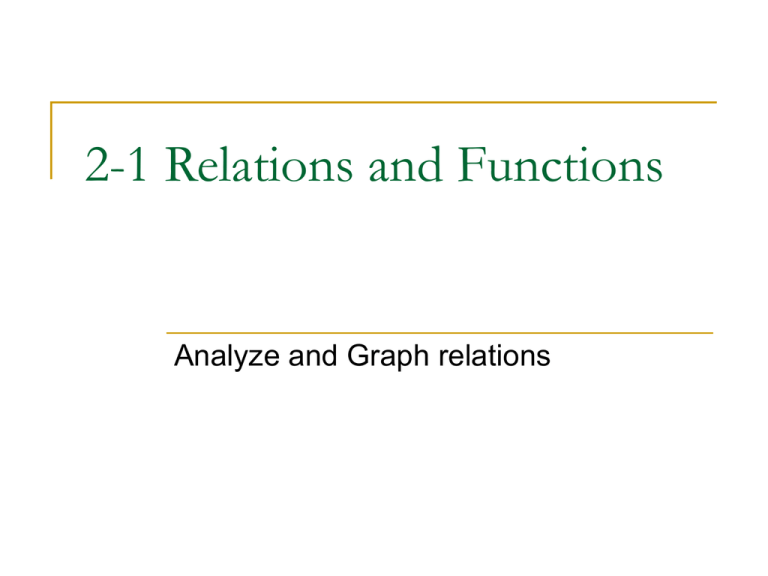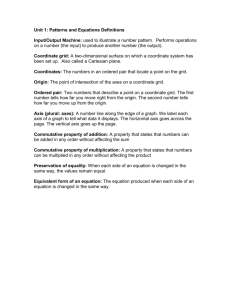2-1 Relations and Functions
advertisement

2-1 Relations and Functions Analyze and Graph relations Domain and Range In a Function the input is Domain, normally x is used for the input The output is the Range, normally y is used for the output Other names Domain is the set of possible inputs, thus it is the Independent Variable (meaning this is the one you get to pick to use) in the function. Range is the set of possible outcomes, thus it is the Dependent Variable ( meaning it is value dependents on the input) in the function. Every element in the Domain go to one element in the Range a b c 1 2 3 This is a function, since element in the domain maps to one element in the range. Even if b and c both map to 2 Every element in the Domain go to one element in the Range a b c 1 2 3 This is NOT a function, since b in the domain maps to 2 and 3 in the range. Vertical Line Test If you pass a vertical line through a graph of a relation and it touches the graph in two or more points, then the graphed relation is not a function. Lets talk about graphing We have to thank Rene Descartes for graphing. René Descartes French: ; (31 March 1596 – 11 February 1650) Descartes' influence in mathematics is equally apparent; the Cartesian coordinate system—allowing algebraic equations to be expressed as geometric shapes (2D coordinate system)—was named after him. He is credited as the father of analytical geometry, the bridge between algebra and geometry, crucial to the discovery of infinitesimal calculus and analysis. The Cartesian coordinate plane Broken into 4 Quadrants II (two) III (three) How to remember the Quadrants? I (one) IV (four) Which one is the X axis or Y axis? The x axis is horizontal The y axis is vertical This gives order pairs (x, y) as points Which one is the X axis or Y axis? The x axis is horizontal The y axis is vertical This gives order pairs (x, y) as points (8, 3) 8 over and 3 up Graphing a function Set up an input/output table where x is the input and the output is the y. Give the equation y = 2x + 1. Place the points on the plane and connect the dots. (x y) (2,5) (1 3) (1, 3) (2 5) (-1, -1) (-1 - 1) Lets graph x = 2 y +1 Here we will put in y and solve for x (x, y) (1, 0) x = 02 + 1 (2, 1) x = 12 + 1 (2, -1) x = (- 1)2 + 1 1 (10, 3) x = (3)2 + 1 ( 10, - 3) x = (- 3)2 + 1 Is x = 2 y + 1 a function? Is x = 2 y + 1 a function? No, it does not pass the Vertical line test. What is its domain? Is x = 2 y + 1 a function? No, it does not pass the Vertical line test. What is its domain? x≥1 How would you solve f(2) = 4x + 1 Replace x with 2 f(2) = 4(2) + 1 f(2) = 9 Homework Page 60 – 62 # 17 – 31 odd, 46 - 53, 70 - 73






